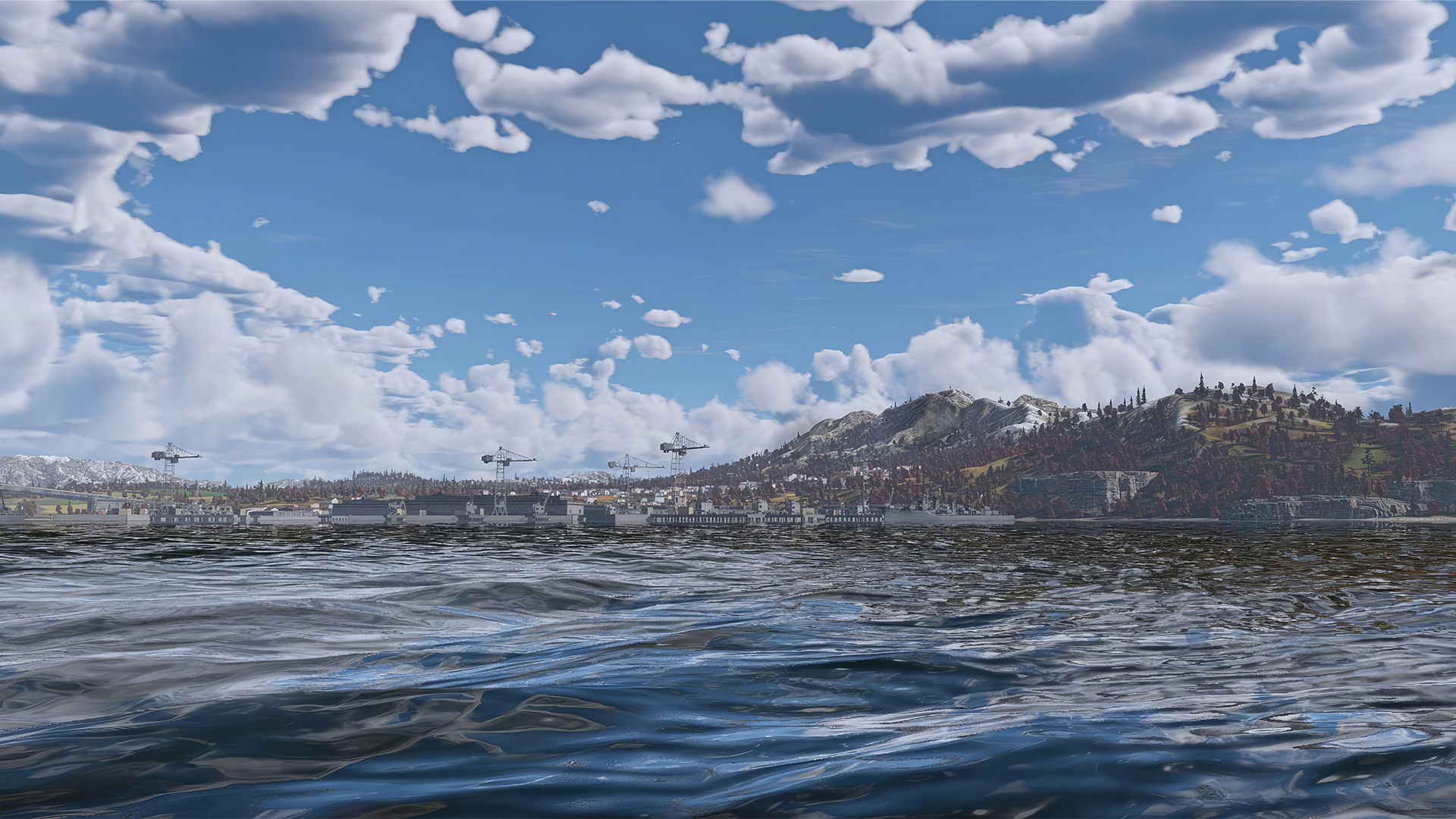夏伯阳
阅读
2024-02-19更新
最新编辑:瓦瑞克Warrick
阅读:
更新日期:2024-02-19
最新编辑:瓦瑞克Warrick
介绍
68K 型(夏伯阳)轻巡洋舰“夏伯阳”号(1950)是苏联远洋海军 IV 级轻巡洋舰,其分房权重为6.0(街机娱乐/历史性能)。 它于1.91版本“夜视”更新后加入游戏。
基本信息
生存性与装甲
装甲 正面 / 侧面 / 背面
装甲盒 120mm / 100mm / 50mm
主炮塔 175mm / 65mm / 60mm
船体 钢,25mm
上层建筑 钢,8mm
船舱 8 节
船员数量 1 184 人
排水量 14 040 吨
夏伯阳有着可靠的装甲,可以抵抗任何 155mm 炮弹。只有布鲁克林之类的穿甲弹持续射击才能造成足够伤害以减少乘员数量。若要抵挡更大的炮弹,需要将船体斜向至45°并朝向攻击者,避免弹药库和动力舱被击穿。
夏伯阳的炮塔可以免疫高爆弹和驱逐舰的穿甲弹,也能抵挡最上之类副炮的攻击。在与巡洋舰对抗时,炮塔对高爆弹有相当高的抵抗力,除了幸运的炮弹会击中其中一门火炮后膛,这只会使炮塔上三门火炮中的一门失效。
甲板装甲足以抵抗250千克的炸弹,但更大的炸弹会造成毁灭性的损伤。
机动性
速度 前进/倒退
街机 71/37km/h
历史与全真 61/31km/h
夏伯阳拥有平均最大速度,加速度稍快。虽然不是游戏中最快的巡洋舰,但比先前的巡洋舰明显快上许多。夏伯阳本质上是一艘手感像驱逐舰的巡洋舰。它具有非常好的响应性和操控性,但尺寸限制了操作速度。
| 机动性 | |||
|---|---|---|---|
| 模式 | 状态 | 最高航速(km/h) | |
| 前进 | 后退 | ||
| 街机娱乐 | 完全体 | 71 | 37 |
| 历史性能/全真模拟 | 完全体 | 61 | 31 |
改装件和经济
最高维修费 白板 → 完全体
街机 12 083 → 15 671
历史 11 655 → 15 116
改装件总成本 97 200
163 300
护身符 1 800
成员组培训费 90 000
专家 310 000
王牌 1 200
王牌(研发点) 570 000
战斗收益 街机 / 历史 / 全真
450% / 600% / 100%
178% / 178% / 178%
武器
主炮配置
4 座炮塔 3 × 152 mm/57 B-38 1938型舰炮
弹药 540 发
垂直射界 -5°/45°
夏伯阳装备了威力强大的 152mm/57 B-38 1938型舰炮。拥有相当高射速和毁灭性爆炸力的致命武器已不是什么新鲜事,B-38 也不例外。它们配备多用途的弹药,从单纯的反舰弹到远距离的防空弹应有尽有。主炮的白板弹药为高爆弹,装药量足以秒杀轻装甲目标。半穿甲弹是实在的万金油,可以摧毁大多数敌舰,和高爆弹相比,它的装药量几乎不变,但穿深有所提升。穿甲弹是之前舰船所没有的,是对付重巡和战列的必备工具。装药量较其他弹种有明显减少,提高了夏伯阳对抗重巡的能力。使用穿甲弹时,瞄准关键部位至关重要。弹药库、动力舱等重要部位都是应该瞄准的地方,因为这些装药较少的炮弹难以造成太大伤害。
| 穿透统计 | |||||||
|---|---|---|---|---|---|---|---|
| 弹药 | 弹药类型 | 0°角时的穿透力 (mm) | |||||
| 1 000 m | 2 500 m | 5 000 m | 7 500 m | 10 000 m | 15 000 m | ||
| OF-35 | 榴弹 | 50 | 50 | 50 | 50 | 50 | 50 |
| B-35 | 风帽被帽穿甲弹 | 333 | 287 | 226 | 178 | 143 | 100 |
| PB-35 | 风帽平头穿甲弹 | 172 | 148 | 117 | 92 | 74 | 52 |
| ZS-35 | 榴弹(时间引信) | 62 | 62 | 62 | 62 | 62 | 62 |
| 弹药细节 | |||||||||
|---|---|---|---|---|---|---|---|---|---|
| 弹药 | 弹药类型 | 初速度 (m/s) |
弹头质量 (kg) |
引信延迟 (s) |
引信灵敏度 (mm) |
装药量(TNT 当量) (kg) |
跳弹入射夹角 | ||
| 0% | 50% | 100% | |||||||
| OF-35 | 榴弹 | 950 | 55 | 0 | 0.1 | 6 | 79° | 80° | 81° |
| B-35 | 风帽被帽穿甲弹 | 950 | 55 | 0.03 | 7 | 1.69 | 48° | 63° | 71° |
| PB-35 | 风帽平头穿甲弹 | 950 | 55 | 0.03 | 7 | 5.9 | 48° | 63° | 71° |
| ZS-35 | 榴弹(时间引信) | 950 | 54.23 | 0 | 0.1 | 10.1 | 79° | 80° | 81° |
副炮配置
6 座炮塔 2 × 100 mm/70 SM-5-1 舰炮
弹药 300 发
夏伯阳是仅有的装备了 100 mm/70 SM-5-1 舰炮的巡洋舰之一+。舰炮的炮塔与 130 mm/58 SM-2-1 舰炮十分相似,只是由于口径缩小,整体性能有所下降。它们的用法和平静号相同,向水上目标倾泻出大量炮弹,也可以充当非常强大的防空炮。没有什么新奇的是,这个武器系统具有相对较高的射速(约30发/分,这是因为使用了双联装炮塔),是53型舰炮的一半。不过,夏伯阳具有4座双联装炮塔,使得实际射速达到了约120发/分,大大高于其他舰艇上见到的大多数大口径武器系统。斯维尔德洛夫则装备了6座这样的炮塔。
该舰炮利用不同的弹药以应对各种情景。或者作为可靠的防空炮点射防御,或者将轻装甲舰艇射成马蜂窝,又或者只是额外的炮塔,令大型舰船的关键部件和武器系统失去作用。该炮拥有在平静主炮中见过的弹药种类,还多了一个新面孔:包括高爆弹、半穿甲弹、近炸弹和定时弹。火炮的用法跟平静号一样简单。增加炮塔数量显著提高了对空能力,不仅因为它能够在空中发射更多的炮弹,而且所有这些炮弹都具有近炸功能。每次齐射8发,每发含有815克炸药,触发距离15米,以995米/秒的速度飞行,每四秒发射一次,这些炮几乎可以保证对任何不幸的飞机造成严重损害。
与平静相比,它的主要缺点是缺少雷达来辅助射击,不过无伤大雅。
| 穿透统计 | |||||||
|---|---|---|---|---|---|---|---|
| 弹药 | 弹药类型 | 0°角时的穿透力 (mm) | |||||
| 1 000 m | 2 500 m | 5 000 m | 7 500 m | 10 000 m | 15 000 m | ||
| OF-55 | 榴弹 | 24 | 24 | 24 | 24 | 24 | 24 |
| ZS-55 | 榴弹(时间引信) | 26 | 26 | 26 | 26 | 26 | 26 |
| F-55 | 榴弹(弹底引信) | 73 | 63 | 54 | 46 | 40 | 34 |
| ZS-55R | 榴弹(近炸引信) | 17 | 17 | 17 | 17 | 17 | 17 |
| 弹药细节 | |||||||||
|---|---|---|---|---|---|---|---|---|---|
| 弹药 | 弹药类型 | 初速度 (m/s) |
弹头质量 (kg) |
引信延迟 (s) |
引信灵敏度 (mm) |
装药量(TNT 当量) (kg) |
跳弹入射夹角 | ||
| 0% | 50% | 100% | |||||||
| OF-55 | 榴弹 | 900 | 15.8 | 0 | 0.1 | 1.93 | 79° | 80° | 81° |
| ZS-55 | 榴弹(时间引信) | 900 | 15.6 | 0 | 0.1 | 1.93 | 79° | 80° | 81° |
| F-55 | 榴弹(弹底引信) | 900 | 15.8 | 0 | 0.1 | 1.93 | 79° | 80° | 81° |
| 近炸弹药细节 | |||||||||||
|---|---|---|---|---|---|---|---|---|---|---|---|
| 弹药 | 弹药类型 | 初速度 (m/s) |
弹头质量 (kg) |
引信延迟 (s) |
引信灵敏度 (mm) |
引信解除 保险距离 (m) |
触发距离 (mm) |
装药量(TNT当量) (kg) |
跳弹入射夹角 | ||
| 0% | 50% | 100% | |||||||||
| ZS-55R | 榴弹(近炸引信) | 900 | 15.9 | 0 | 0.1 | 270 | 15 | 1.23 | 79° | 80° | 81° |
对空武器
14 座炮塔 2 × 37mm V-11 双联装防空炮座
弹药 4000 发
弹匣容量 5 发
射速 180 发/分钟
正如在科技树上看到的每一艘苏联舰船一样,37mm 防空炮也是防空炮里的老熟人了。仅与以前的船只相比,夏伯阳能和平静相媲美。平静装备了16门 45mm 自动炮,而夏伯阳装备了28门 37mm 自动炮。按比例来说两者都差不多,但总的来说,火炮总是越多越好的。这些炮与之前看到的配备37毫米火炮的舰艇没什么不同,都具备一些反舰能力。
实战中的使用
夏伯阳和之前的巡洋舰十分相似,但是火力有明显加强。它可以胜任许多角色,但最适合与敌人的驱逐舰和巡洋舰决战。虽然不建议这么做,但是可以利用高射速主炮和众多的炮台在肉搏战中制造优势。当它可以在没有还击的情况下从中距离朝敌舰开火时,或者用其高射速的火炮支援更大的巡洋舰或战列舰时,这艘船的体验无疑是极好的。
优点与缺点
优点
- 舰员数量多,生存性强
- 防空炮缓慢但有效,建议使用 100mm 副炮的近炸弹
- 非常灵活
- 中部遭到少量雷击后仍能存活
缺点
- 无动力改装的情况下,航行速度缓慢
- 惊人的射速
- 没有水泵改装件容易快速进水
- 弹药库防护薄弱
历史
The Soviet cruiser Chapayev (Чапаев) was the lead ship of her class of light cruisers built for the Soviet Navy before and after the Second World War. Initially designed as a follow-up to the previous Kirov-class cruisers, the ship was laid down and launched at the start of the Second World War before construction was halted due to the German invasion. Chapayev was completed after the war, albeit to an altered design with heavily-increased anti-aircraft armament. However, due to the advent of advanced weapons systems such as guided missiles, the ship was made obsolete extremely quickly. Chapayev was reduced to a training ship in 1960, and sold for scrap by 1963.
设计与研发
The Chapayev class, or Project 68, was designed as a follow up to the previous Kirov class of light cruisers. The ships were designed with a new main armament of twelve 6-inch guns, compared to the nine 7-inch guns of the Kirov class. The ship was also significantly larger, displacing almost 5,000 tons more than the preceding Kirovs. Initially, it was planned that a total of 17 ships would be built, but only seven ships had been started when the Germans invaded. The Chapayev was the first of these ships, launched in 1941 just before the invasion. Two of the seven hulls were destroyed on their slipways by the German forces, but the remaining five vessels were completed after the war in 1950.
Chapayev displaced 14,000 tons full load and had a complement of 840. Her main armament consisted of twelve 6-inch (152 mm) guns in four triple mounts, similar to the comparable British and American cruiser classes. Being completed after the war, she also carried an extremely heavy anti-aircraft armament of eight 100 mm dual-purpose guns in double mounts, and 28 × 37 mm anti aircraft guns. She also had six beam torpedo tubes, which were removed later on. Chapayev had been built with a seaplane catapult and hangar, but these were swiftly removed before her completion as there was no need for them in the postwar naval environment.
服役动态
After her completion, Chapayev entered service with the Russian 4th Fleet. In July of 1951, she was transferred to the Black sea fleet. The advent of the Chapayevs and Sverdlovs was a huge shock for the United Kingdom, and resulted in the development of the Blackburn Buccaneer as an effective anti-ship aircraft designed to counter them. However, due to the advent of the guided missile, Chapayev soon became obsolete. She was withdrawn from the fleet in April of 1958 and used as a training ship between 1958 and 1963. In October of 1963, she was sold and scrapped by early 1964.
开发日志
In July 1937, the USSR formally joined the 1936 London Naval Agreement. Having agreed to the restrictions imposed by the treaty, Soviet shipbuilders began developing a new light cruiser design around the treaty limitations. However, it quickly became clear that it wasn't possible to match the new design against both treaty limitations and naval needs, despite the already applying weight saving measures. As a result, the decision was made to disregard the treaty restrictions in March 1938, with the design already being approved by the following year.
Initially, 26 ships of the Project 68 cruisers were planned for construction. However, initial construction difficulties resulted in only 7 ships being laid down, of which 4 were later launched. The subsequent German invasion in June 1941 led to all work on ships of the Project 68 class to be suspended.
Following the end of WWII, Soviet shipbuilders quickly realized that, due to the appearance of new technologies and tactics, vessels such as the Project 68 ships were no longer suitable for modern naval combat. Thus, the decision was made to restart their construction under a modernized design. The lead ship of this class was the Soviet light cruiser Chapayev.
Chapayev was laid down in October 1939 and launched in April 1941. Having its construction suspended during the war, it was only restarted in the late 1940s, with the ship finally seeing completion and entering service with the Soviet Navy in May 1950. Chapayev served until 1958, before being assigned to support roles leading up to its retirement. In the early 1960s, the ship was ultimately decommissioned from service and was subsequently broken up for scrap in 1964.[1]
媒体
图片
皮肤
另见
外部链接
| |||||||||||||||||||||||||||||||||||||||||||||||||||||||||||||||||||||||||||||||||||||||||||||||||||||||||||||||||||||||||||||




 沪公网安备 31011002002714 号
沪公网安备 31011002002714 号